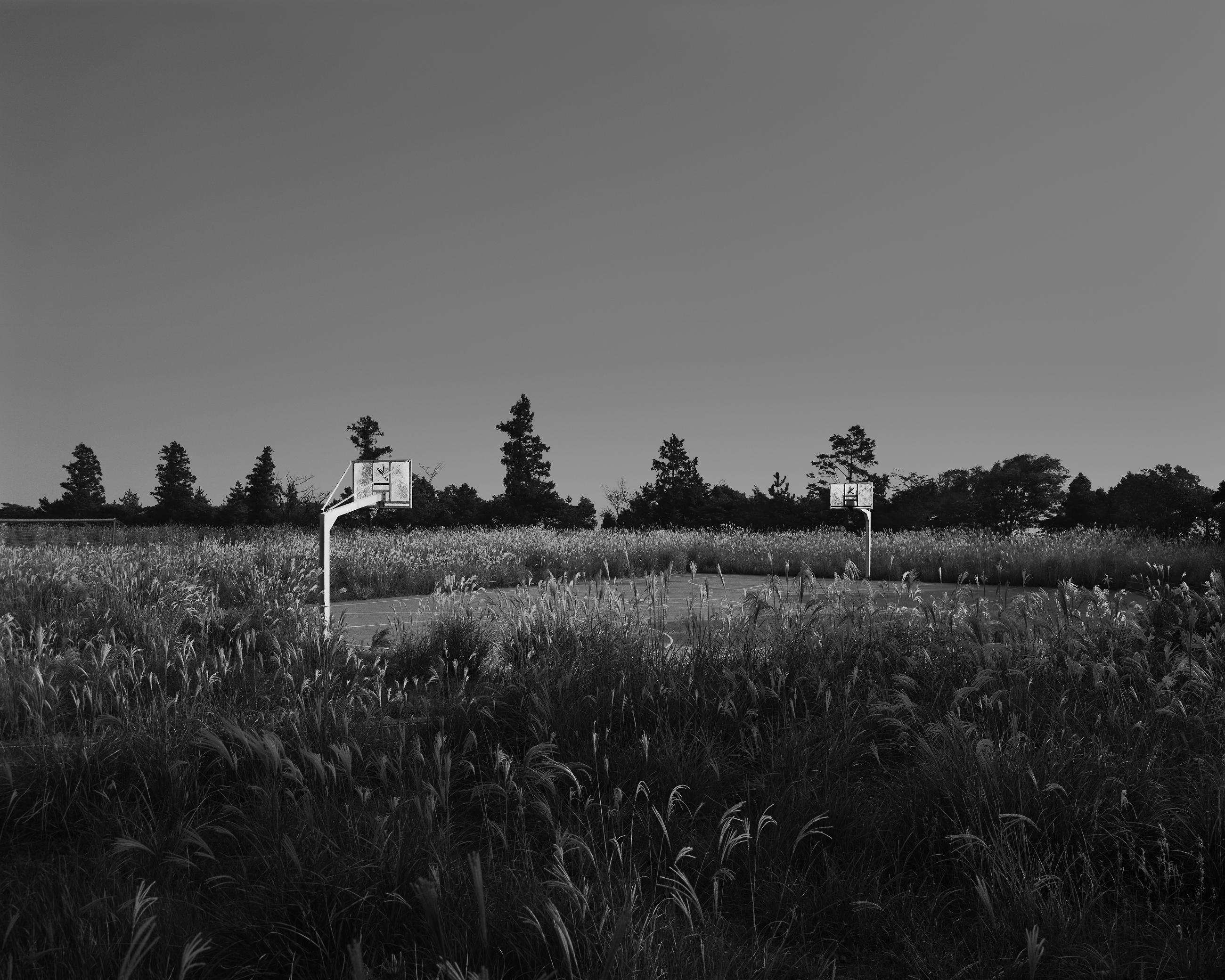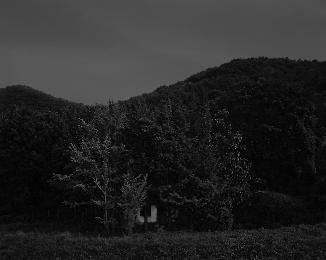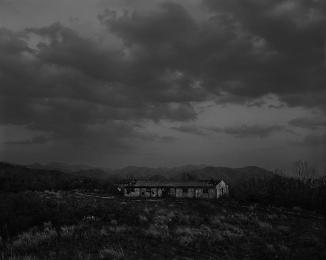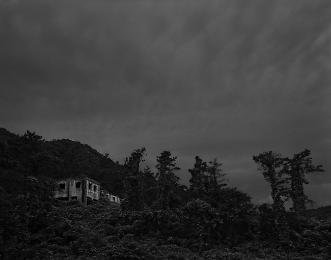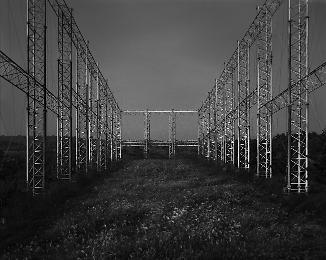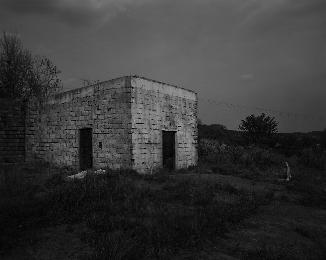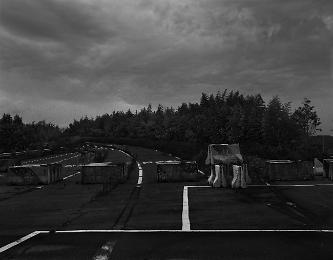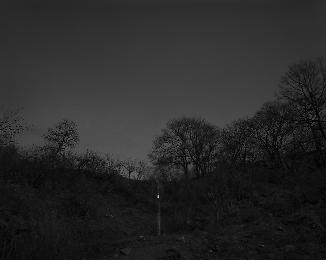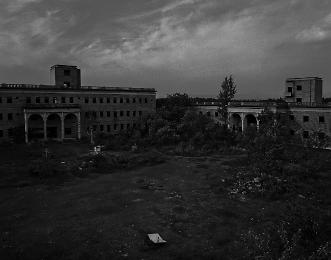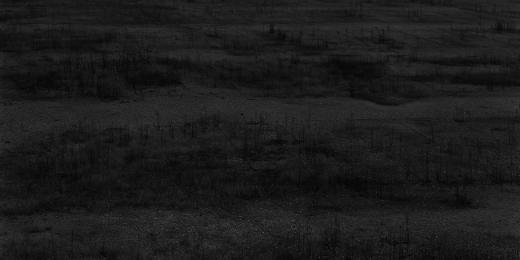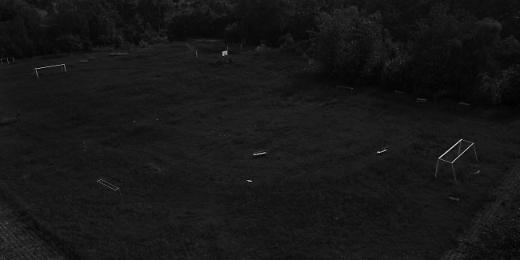이건영 개인전 <흰 그늘진 마당>
폐기된 공간 혹은 마음의 공간
이건영의 사진들은 공간을 보여준다. 그 공간들은 이름 없는 공간들이다. 이름이 없다는 것은 공간이 처음부터 이름이 없어서가 아니라 지녔던 이름을 언제부터인가 잃어 버렸기 때문이다. 하지만 자세히 들여다보면, 그 공간들의 이름이 없는 건 다만 지녔던 이름을 상실했기 때문만은 아니다. 그 이름 없음은 공간들이 아직은 무엇이라고 분명하게 명명할 수 없는 모종의 공간으로 변해가고 있기 때문이다. 말하자면, 이건영의 프레임 안에 들어있는 여러 공간들은 모두가 과정의 공간 - 이것도 아니고 저것도 아닌 혹은 이것이기도 하고 저것이기도 한 경계의 공간들이다. 그렇다면 이 과정의 공간들, 경계의 공간들의 이름이 무엇일까? 그 공간의 이름 찾기를 통해서 이건영의 사진들은 어떤 메시지를 전달하고자 하는 것일까?
이건영의 사진이 보여주는 건 모두가 버려진 공간들이다. 그의 사진 속 공간은 예전에는 어떤 목적으로 사용되었으나 그 용도를 잃어버리고 목적을 상실해 버린, 그래서 사람들이 떠나버리고 남아 있는 버려진 공간들이다. 흰 소금들이 생산되었으나 지금은 키 큰 잡초들만 바람에 흔들리는 옛 염전터, 한때에는 시끄러운 운동장이었으나 놀던 아이들이 모두 떠나버린 옛 학교터, 본래는 고기들의 놀이장이였으나 지금은 댐으로 수량이 모두 방수되어 햇빛 아래 지면이 되어버린 옛 호수터 등 이건영이 렌즈로 포착하는 공간들은 모두 폐기된 공간들이다. 그리고 이 폐기된 공간들의 이미지를 응시하면서 우리가 무엇보다 먼저 받아들이게 되는 건 뉴 토포그래픽스(New Topographics)의 사진들이 그러하듯, 인간의 목적에 의해 개발되어 사용되었다가 그 목적이 다한 뒤에 폐허로 남겨진 자연의 모습들, 즉 자연 위에 가해지는 이기적 문명의 자연 파괴이다. 그런 점에서 이건영의 폐기된 공간들은 상처 입은 자연의 얼굴들이다.
하지만 이건영의 사진들이 폐허가 된 공간을 보여주면서 전달하고자 하는 메시지가 다만 자연에게 폭력을 가하는 이기적 문명에 대한 비판만은 아니다. 자세히 들여다보면, 그의 사진 안에 포착된 그 폐기된 공간들은 헐벗은 폐허의 공간이기도 하지만 그 위에서 모종의 사건이 일어나고 있는 공간이기도 하기 때문이다. 그것이 키 큰 조명등들만 외롭게 서있는 버려진 주차장이든, 불법 폐차장으로 변해버린 산골짜기 계곡이든, 골프공들만 군데군데 구르는 메마른 땅이든 이건영의 어두운 폐허 공간 안에는 자연의 상처 입은 얼굴만이 아니라 그 상처의 바닥 위에서 자라나고 있는 또 다른 자연의 얼굴이 함께 들어 있다. 염전터의 키 큰 풀들이 그렇고 지면이 된 수중면 위에서 싹트는 잡초들이 그렇고 전신주 주변으로 벌써 무성히 웃자란 나무들이 그렇다. 말하자면 이건영의 사진 공간은 한편으로는 파괴당한 자연의 얼굴이지만 다른 한편으로는 그 폐허 위로 다시 회귀하는 자연이 함께 존재하는 이중의 공간이 된다. 이러한 이중의 공간 이미지는 보는 이에게 자연의 멈추지 않는 생명력, 즉 문명으로 아무리 상처를 받아도 그 상처를 허파 삼아 다시 생명을 일깨우는 자연의 자기 순환적 생성력을 새삼 깨닫게 만든다. 그런 점에서 이건영의 폐기된 공간들은 폐허 공간이 아니라 오히려 생성의 공간이다.
그러나 또 하나의 공간이 있다. 어쩌면 이건영으로 하여금 도시 외곽으로 또 지방의 어느 지역으로 폐허의 공간을 찾아다니게 만들었던 정작의 이유일 수도 있는 그 공간은 그러나 사진 이미지 안에서는 드러나지 않는 공간, 말하자면 심미적 공간이다. 이 공간은 폐허의 공간과 생성의 공간이 겹쳐지는 곳 혹은 그 두 공간의 겹침이 심미적으로 보는 이에게 연상케 하는 제 3의 어느 장소이다. 그 특별한 장소는 문명이라는 이름으로도, 자연이라는 이름으로도 명명할 수 없는 이름 없는 공간, 말하자면 유토피아적 공간이다. 이건영이 카메라를 들고 찾아다니는 어느 곳, 보는 이에게 공간의 이중화를 통해서 보여주고자 하는 제 3의 공간이 그 어떤 이름으로도 명명할 수 없는 유토피아적 공간이라면 이 공간은 어디일까? 혹시 그곳은 그 자신이 찾아다니고 또 도착하고 싶어 하는 마음의 공간은 아닐까? 이 시대를 살아가는 우리들의 마음 공간이 수없이 많은 정보들로 해체되고 범람하는 욕망들에게 점령당한 혼돈의 공간이라면 이건영의 경우도 다르지 않을 것이다. 그 또한 어느 날 그 어떤 우연한 계기가 있어 빼앗긴 마음의 공간을 기억했을 것이고, 그곳을 다시 찾고 싶었을 것이며, 그래서 폐허와 생성이 공존하는 이름 없는 공간을 프레임 안에 담았을 것이다. 그런 점에서 이건영의 폐기된 공간들은 그 자신만이 알고 있는 내밀한 마음의 공간인지 모른다. 하지만 그렇게 자기만이 알고 있는 특별한 공간을 마음 안에 갖고 있지 않은 사람이 누가 있겠는가? 우리가 이건영의 폐기된 공간들 앞에서 잠깐 걸음을 멈춘다면, 그 또한 그 폐허 속 생성의 공간들이 우리들을 저마다의 마음 공간으로 데려가기 때문일 것이다.
김진영/ 예술비평
이건영 개인전
Deserted Spaces or Spaces of the Heart
The photographs of Gun Young Lee show spaces. These spaces are nameless. It's not that they did not have a name to start with, but that somewhere along the line, they lost the name that they once had. But upon a closer look, we find that the reason for their namelessness is not just that they lost the name that they had. Rather, they are turning into something that cannot yet be called any definite name. In other words, the various spaces within Lee's frames are all spaces in process - spaces of boundaries, which are neither this nor that, or both this and that. What, then are the names of these spaces in process, spaces of boundaries? And what message can be derived from seeking a name for these spaces in these photos?
All of Lee's photos show spaces that have been deserted. They were once used for a certain purpose, but having lost their use and been cast away, no one is there any more. An abandoned salt field now occupied by tall weeds swaying in the wind, the playing field of a closed school once filled with children running around freely, the site of an old lake where fish were plentiful now a parched up piece of land under the bright sun after a dam was built and all the water was discharged... Looking at the images of these deserted spaces, what we perceive before anything else, as happens with photos of New Topographics, are the ruins of nature, developed and used to human purpose and abandoned once the purpose has been served, that is, the destruction of nature by civilization's selfishness. In this aspect, the deserted spaces of Lee are the wounded faces of nature.
Nevertheless, the message being conveyed through the spaces of ruins in Lee's photos goes beyond criticism of civilization's violence against nature. Looking carefully, we see that while the deserted spaces captured in his photos are barren and in ruins, they are also each a scene where a certain event is taking place. Be it an abandoned parking lot with tall lights standing lonesomely, a mountain valley turned into an illegal junkyard, or a barren ground scattered with golf balls, the dark ruins of Lee’s works contain not only the wounded faces of nature, but also faces of a different kind that are growing out of those wounds. They could be the tall weeds in the abandoned salt field, grass coming out of the dried up land once a lake, or the trees that have grown thickly around a telegraph pole. In short, the photographic spaces of Lee are twofold, where on the one hand, there is the ravaged nature, and on the other hand, there is the return of nature to the ravages. This twofold image brings to light the self-circulating vitality of nature, which no matter how badly it may have been wounded by civilization, will work its way through those wounds and reawaken life. In this sense, the deserted spaces of Lee are not spaces of ruins but rather spaces of creation.
But there are spaces of yet another kind. Perhaps the actual reason behind Lee's search through the outskirts of cities and local areas for deserted scenes, these are spaces that are not apparent within the photographic image, but rather aesthetic. The viewer makes associations based on the intersecting points of the spaces of ruins and the spaces of creation, or the overlapping of these spaces, which generates an aesthetic place of a third kind. This special place cannot be called by the name of civilization or that of nature. Spaces of this kind are nameless, utopian. If these spaces of a third kind which Lee tries to capture with his camera and present to the viewers through a twofold image are utopian and cannot be named in any way, where could these spaces be? Could they be spaces of the heart that he is searching for and hopes to reach? If spaces of our hearts in these times are those of chaos, disintegrated by countless information and occupied by overflowing desires, the same must be true with Lee. One day, quite by accident, he would have remembered a space of the heart now deprived, wanted to find it again, and hence captured in a frame a nameless space where ruins and creation coexisted. In this sense, the deserted spaces of Lee may be secret spaces of the heart that only he knows of. But then again, who does not have a special space of the heart of their own? If we are brought to stop and look the deserted spaces of Gun Young Lee, it may be that the spaces of creation within the ruins are transporting us to our very own spaces of the heart.
Kim Jin-Young/ Art Critic
 작품을 클릭하시면 큰 화면으로 감상하실 수 있습니다.
작품을 클릭하시면 큰 화면으로 감상하실 수 있습니다.





